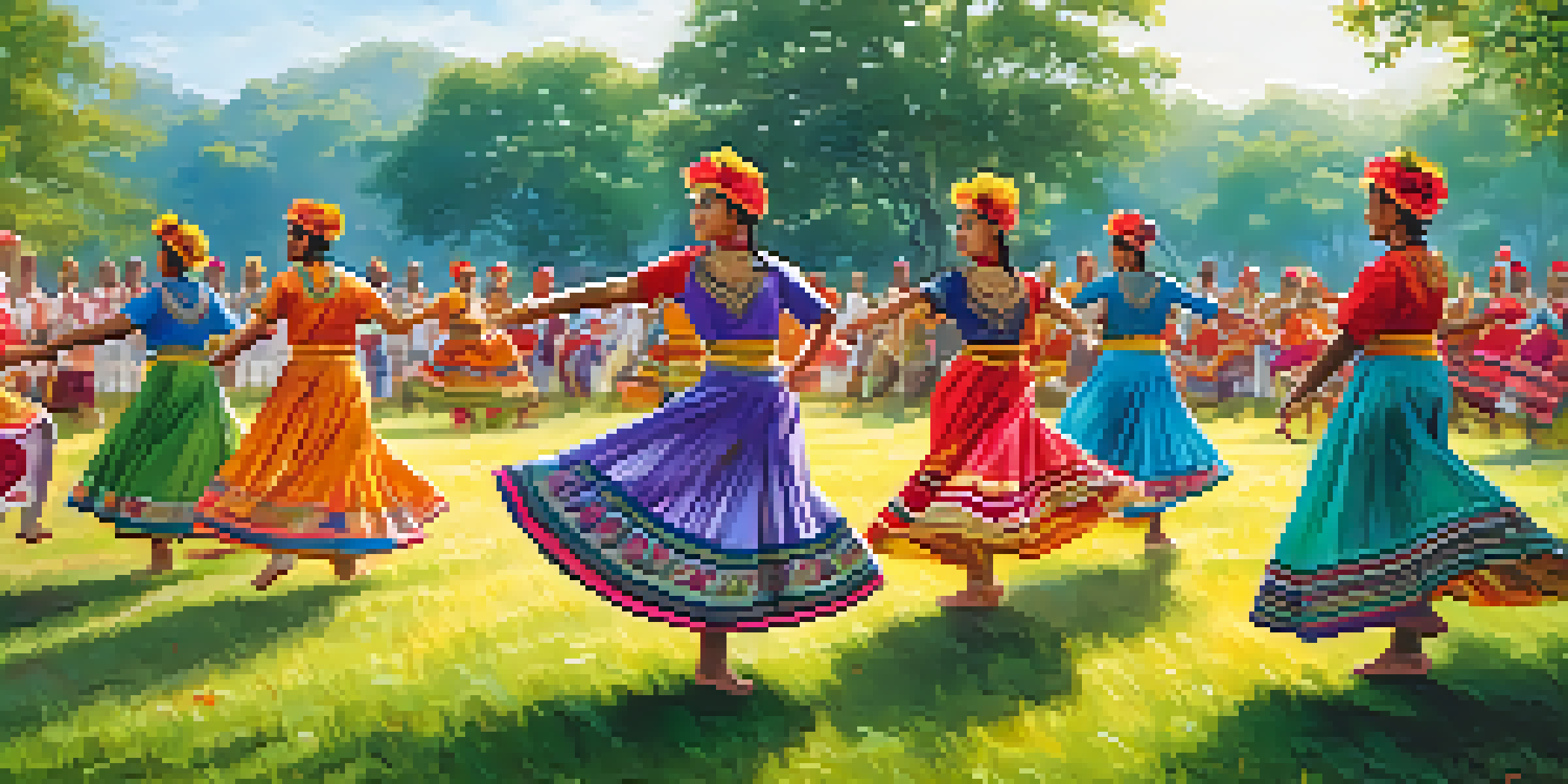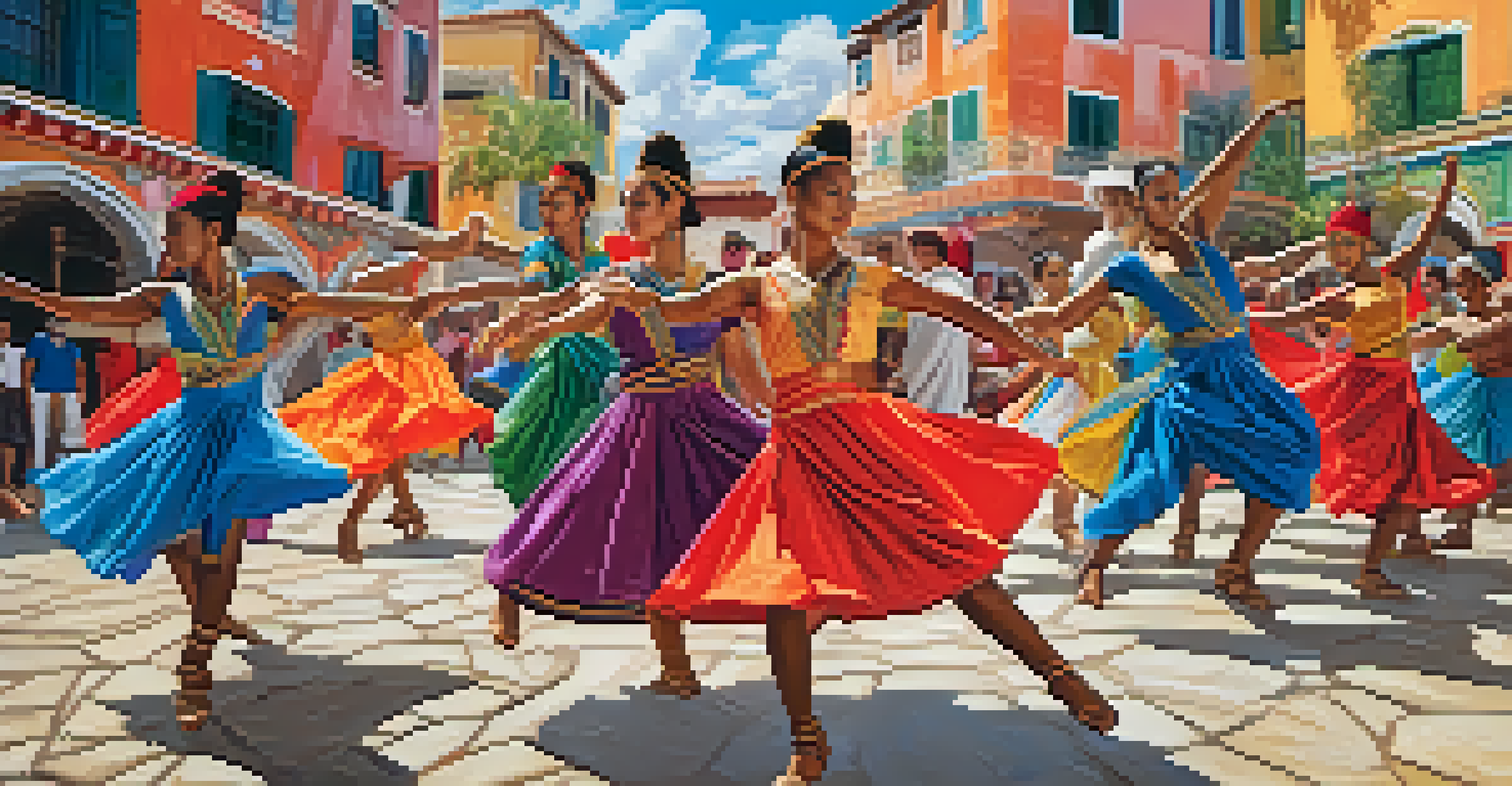The Role of Dance in Documenting Cultural History

Dance as a Living Archive of Cultural Identity
Dance is more than just a form of expression; it's a living archive that captures the essence of cultural identity. Through movement, communities tell their stories, passing down traditions and values from generation to generation. For instance, traditional folk dances often convey historical events, social norms, and community beliefs that shape a group's identity.
Dance is the hidden language of the soul.
In many cultures, specific dances are tied to important life events, such as weddings or harvest festivals, and serve to reinforce communal bonds. When we watch these dances, we are not just spectators; we are witnesses to a shared history. This continuity of tradition helps maintain a sense of belonging, even as societies evolve.
As globalization spreads, preserving these dance forms becomes crucial. They act as a reminder of our roots, providing insight into the diverse tapestry of human experience. Dance embodies the spirit of a culture, making it a powerful tool for cultural documentation.
Historical Narratives Told Through Dance
Dance has been used throughout history to narrate important events and convey societal changes. For example, the African American traditions of the cakewalk and the Charleston evolved from historical contexts reflecting social struggles and triumphs. Each step and movement tells a story, allowing us to glimpse into the lives and times of those who came before us.

Moreover, many Indigenous cultures use dance as a way to recount their histories and spiritual beliefs. Ceremonial dances often depict creation myths and clan stories, preserving knowledge that might otherwise be lost. Through rhythm and movement, these dancers keep their histories alive, ensuring that future generations can learn from the past.
Dance Preserves Cultural Identity
Dance serves as a living archive, conveying the essence of cultural identity and shared histories through movement.
By documenting these performances, dance becomes a historical source, much like written texts. Researchers and historians can analyze dance to understand cultural shifts and social dynamics, making it an invaluable asset in historical studies.
The Role of Dance in Cultural Exchange
Dance is a dynamic medium for cultural exchange, allowing different communities to share and learn from one another. When people from diverse backgrounds come together to dance, they create a melting pot of ideas, movements, and styles. This exchange enriches cultural narratives, as new forms emerge from these interactions, reflecting a blend of influences.
The dance is a poem of which each movement is a word.
Consider how ballet, originally a European art form, has been influenced by various cultural dances worldwide. The incorporation of African, Asian, and Latin American elements into contemporary ballet showcases how dance evolves through cultural dialogue. These fusions not only enhance the art form but also serve as documentation of cultural interactions over time.
As dance continues to evolve, it reflects the changing societal landscape. This adaptability allows it to serve as a living record of cultural exchanges, illustrating how communities respond to and influence one another across borders.
Dance Documentation in the Digital Age
In today’s digital age, the documentation of dance has taken on new dimensions. With the rise of social media platforms like TikTok and Instagram, dances can be recorded, shared, and preserved instantaneously. This accessibility allows for broader audiences to engage with diverse cultural dances, ensuring they reach beyond geographical boundaries.
Moreover, digital archives and online platforms are now dedicated to preserving traditional dances, making them accessible to anyone interested in learning. This democratization of information empowers communities to share their heritage while also providing a resource for educators and researchers.
Digital Age Enhances Dance Preservation
The rise of social media allows for instant documentation and sharing of diverse cultural dances, broadening their reach and accessibility.
However, this digital documentation also raises questions about authenticity and representation. It’s essential to approach the sharing of cultural dances with respect, ensuring that the origins and meanings are honored, so the stories behind the movements remain intact.
The Therapeutic Role of Dance in Cultural Preservation
Dance serves therapeutic purposes, allowing individuals to connect with their cultural heritage in meaningful ways. Engaging in traditional dances can foster a sense of pride and belonging, especially for younger generations who may feel disconnected from their roots. This reconnection can be particularly impactful in multicultural societies where identities might blend or clash.
In therapeutic settings, dance can be a powerful tool for healing, as it allows individuals to express emotions and experiences tied to their cultural background. By participating in group dances, individuals not only heal personally but also contribute to the preservation of their cultural history through shared experiences.
Furthermore, initiatives that focus on reviving traditional dances can strengthen community ties and foster intergenerational dialogue. By engaging in these practices, communities not only safeguard their cultural heritage but also empower individuals to take pride in their identity.
Challenges in Preserving Dance as Cultural Heritage
Despite its importance, preserving dance as a cultural heritage faces numerous challenges. Globalization often leads to the commercialization of traditional dances, which can strip them of their authentic meaning. As dance becomes a product for entertainment, the rich cultural narratives tied to it may be diluted or lost altogether.
Additionally, many traditional dances are at risk of disappearing as older generations pass away without passing on their knowledge. This loss highlights the urgency of documentation efforts, as well as the need for mentorship programs that connect elders with youth. Without these connections, rich histories may vanish without a trace.
Challenges in Cultural Dance Heritage
Globalization and commercialization threaten the authenticity of traditional dances, highlighting the urgent need for preservation efforts.
Moreover, there is often a lack of funding and resources dedicated to the preservation of cultural dance forms. Advocating for support and recognition of dance as an integral part of cultural heritage is essential for ensuring its survival and continued documentation.
Celebrating Dance as a Cultural Heritage Resource
Ultimately, celebrating dance as a vital cultural heritage resource opens doors for appreciation and understanding. By recognizing the stories embedded in dance, we can foster a deeper respect for diverse cultures. Cultural festivals and dance exhibitions offer platforms for communities to showcase their heritage, inviting others to learn and participate.
Educational programs that emphasize the historical significance of dance can help instill an appreciation for this art form in younger generations. By incorporating dance into school curricula, children can explore the rich histories and narratives tied to different movements, nurturing a sense of pride in their cultural backgrounds.

As we celebrate dance, we also honor the resilience of cultures that have used movement to tell their stories. By continuing to document, preserve, and share these dances, we ensure that the vibrant tapestry of human experience remains alive for future generations.